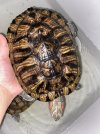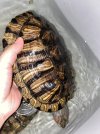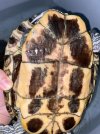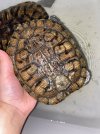Daisyandkenny
New Member
First thing I didn’t even know they had websites where people talk about their turtles so I’m really happy I found one. Anyways Hi I have 2 Red-eared slider boy and girl. I’m cleaning their tank and I notice this and wanted to ask for help also I had them since they were babies and Kenny had this on top of his shell I thought it would’ve went away and it’s back again. Also saw a small dent just now it’s not soft their shells are pretty hard and when I noticed daisy shell at the bottom she has this greyish thing and she’s never had that and now I’m worried. Has anyone went through this? I feel like it’s my fault they have this  🥺🥺😞😞 please help!! I give them their food and I also feed them fruits they aren’t too happy with lettuce when I give it to them but they LOVE bananas. I give them the dry shrimps, those blood worms that are in the freezer at the shop my friend told me I can give them that as well . Any advice ? If it’s their diet or maybe the set up they have anything will help. I’m here ready to take notes
🥺🥺😞😞 please help!! I give them their food and I also feed them fruits they aren’t too happy with lettuce when I give it to them but they LOVE bananas. I give them the dry shrimps, those blood worms that are in the freezer at the shop my friend told me I can give them that as well . Any advice ? If it’s their diet or maybe the set up they have anything will help. I’m here ready to take notes  . I’ll send some few pictures 🥰
. I’ll send some few pictures 🥰




